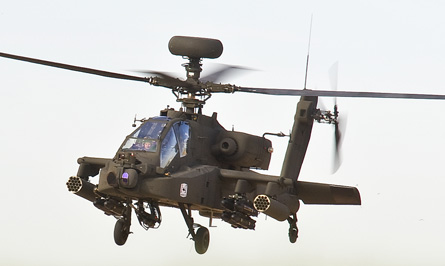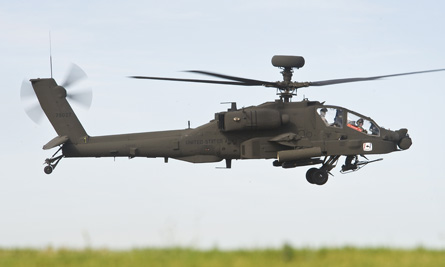Boeing is proposing a host of new performance, survivability and advanced crew station technologies to address performance gaps identified by the US Army in its long-range plans for the AH-64D Apache.
Although they are targeted as packaged upgrades, starting with Lot 7 of the Block III version of the attack helicopter in 2016, many of the technologies could be individually retrofitted to the existing fleet sooner, says Boeing.
First flown in July and set for service entry in 2011, the Block III Apache (below) will include composite main rotor blades, a new split-torque face gear transmission that increases the combined power limit from the twin 1,900shp (1,415kW) General Electric T701D engines to 3,400shp, from 2,860shp, and command, control and weapons firing capabilities for unmanned air vehicles. The army ultimately plans to build 634 Block III aircraft, most of which will be remanufactured from existing AH-64Ds.
 |
|---|
|
© Boeing |
Performance upgrades for a subsequent Block III Extended standard will include a lighter composite after-body, composite tail rotors and a 3,000shp drop-in engine replacement.
Boeing hopes to begin flying an engineering model of a composite after body (tail boom, vertical stabiliser and horizontal stabiliser) next year, and says the structure will cost the same as the existing metal design, but will be lighter and require less maintenance. Larry Plaster, manager of Apache modernisation at Boeing's Mesa, Arizona production facility, says engineers are also developing composite tail rotor blades that will attach to the existing metal hubs.
The Block III Extended Apache could be the beneficiary of a new engine as part of the army's Advanced Affordable Turbine Engine programme. GE and a Honeywell/Pratt & Whitney team have been funded to demonstrate a 3,000shp drop-in replacement that features a 65% improvement in shp/weight ratio and a 25% improvement in specific fuel consumption over the T700. If such an engine comes to fruition, Plaster says the Apache's main rotor hub and tail rotor drive will have to be strengthened and the main transmission modified, with one possible solution being to move from a four- to five-blade main rotor.
In terms of survivability, Boeing is proposing to add a hostile fire indication system to automatically detect and destroy sources of ground fire and rocket-propelled grenades. Improvements to the Apache's infrared and acoustic signature are also possible, as is the incorporation of lighter armour for the airframe and transparent armour capable of stopping 7.62mm rounds for the cockpit.
To enhance crew situational awareness, Boeing is proposing a 360° distributed aperture system that will be integrated with a helmet-mounted cueing system, similar to that in development for Lockheed Martin's F-35 Joint Strike Fighter. Plaster says Apache pilots escorting ground convoys have complained that the AH-64D's extended forward avionics bays are so wide that they have to weave to see the route ahead. While making the bays slimmer is not an option, he says synthetic vision technologies, coupled with a helmet-mounted display, could give pilots an unobstructed view in any direction.
Source: Flight International
























